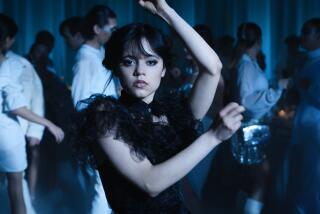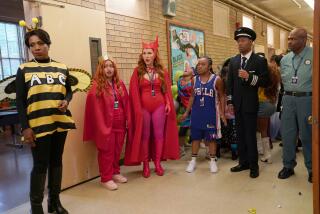For Some Tots, Halloween Is Truly a Fright Night
- Share via
BOSTON — Joe Rutkowski’s son, Keith, was so frightened by the ghouls and goblins arriving at his family’s house last Halloween that he refused to go near the door.
“He was scared to death of all the kids coming to the door in a costume,” Rutkowski of Sharon, Mass., said of his then 3 1/2-year-old boy. “He ran. We couldn’t get him near the door.”
Christine Burns’ daughter, Elyse, who was eight months last Halloween, was afraid of visitors at the door and clung to her mother in alarm when playmates crowded into her living room dressed as ghosts, witches and cartoon characters.
“She wanted to be held and reassured. She would just get upset and really clingy,” said Burns of Wellesley, Mass.
While some children plan their Halloween costume for weeks and work themselves into an excited frenzy Oct. 31, others become terrified by the distorting disguises and back away from participating.
The problem is common among 2- and 3-year-old toddlers, said Joseph Cunningham, a developmental and clinical psychologist at Brandeis University in Waltham, Mass.
“It has to do with their developing capacity to understand how people can change and remain the same in other respects,” Cunningham said. “Alterations in the appearance of a person can be frightening because they’re still a little shaky in their ability to understand how that can happen.”
Older children can better distinguish between fantasy and reality. They delight in the knowledge they can control a frightening situation simply by removing the mask, Cunningham said.
Karen Eichenlaub, a head teacher at Brandeis’ Lemberg Children’s Center, said staffers there soothed fears about a visiting clown’s exaggerated facial features and “tremendously large red shoes” by having the clown don his makeup in front of the children.
Rutkowski calmed his son’s fears by having costumed children at the door remove their masks--a response Cunningham recommends.
“I suggest that the parent talk with the child about how they’re feeling, maybe fill in some of the gaps with something like, ‘Boy, that’s scary to see Michael look like Dracula. He never looked like that before, did he? But you know he can take that off and he’s still Michael. See?’ ”
Some children dress up, head out the door and are about to start trick or treating when “bingo--they don’t want anything to do with it,” Cunningham said.
“The most important thing is to verbalize what you’ve seen the child express. That they’re not sure they want to do this anymore. It’s a little scary and it’s OK if they decide they don’t want to do this,” he said. “Sometimes that’s all they need to regather their strength and plunge ahead.”
What parents shouldn’t do, he said, is dismiss the child’s fear with a “Come on, all the other kids are doing it.
“It’s likely to make them more apprehensive . . . it doesn’t give them an opportunity to understand what it is they’re feeling.”


